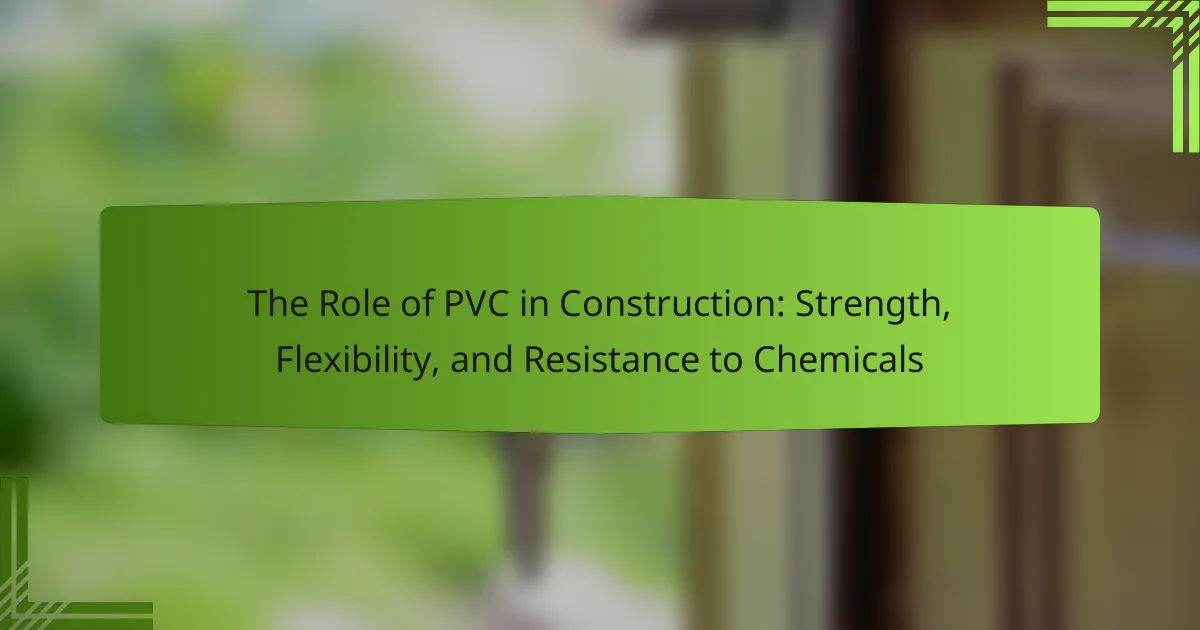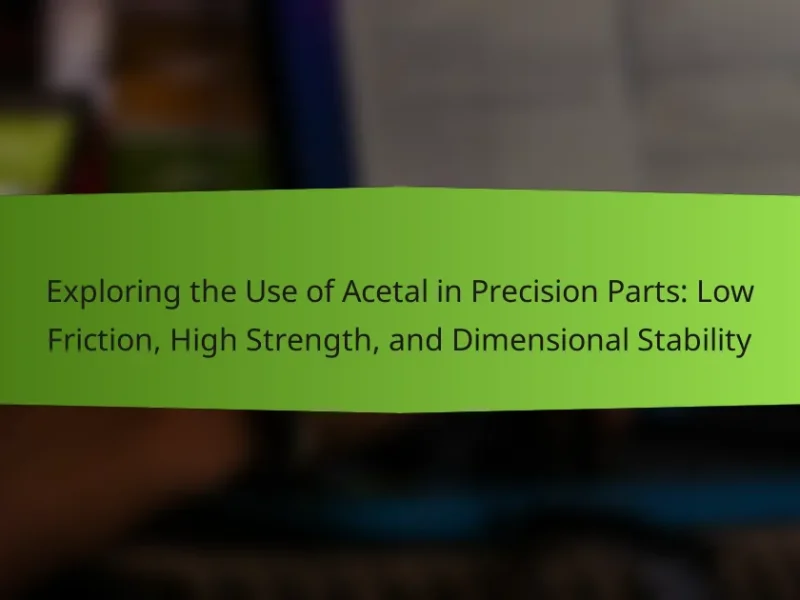Polyvinyl chloride (PVC) is a vital material in construction, known for its strength, flexibility, and chemical resistance. It is extensively utilized in applications such as pipes, siding, and window frames, making it suitable for both residential and commercial use. PVC’s durability and moisture resistance contribute to its effectiveness in preventing mold and mildew growth, while its cost-effectiveness enhances its appeal in construction projects. Best practices for using PVC include selecting high-quality materials, adhering to installation guidelines, and implementing regular maintenance to ensure longevity and performance in various environments.

What is the role of PVC in construction?
PVC, or polyvinyl chloride, plays a crucial role in construction due to its strength, flexibility, and resistance to chemicals. It is widely used in pipes, siding, and window frames. PVC’s durability makes it suitable for both residential and commercial applications. Its flexibility allows for easy installation and adaptation in various environments. PVC is also resistant to moisture, which helps prevent mold and mildew growth. Additionally, it is cost-effective compared to other materials. According to the Plastics Industry Association, PVC is one of the most commonly used plastics in construction, contributing significantly to energy efficiency in buildings.
How is PVC used in various construction applications?
PVC is used in various construction applications due to its durability, flexibility, and resistance to chemicals. It serves as a material for pipes, which are widely utilized in plumbing and drainage systems. PVC pipes are lightweight and resistant to corrosion, making them ideal for water supply and waste management. Additionally, PVC is employed in window frames and doors because of its weather resistance and low maintenance requirements.
In roofing, PVC membranes provide waterproofing and energy efficiency. PVC is also used in flooring materials, offering a variety of designs and ease of installation. Its insulation properties make it suitable for electrical conduits. The versatility of PVC allows it to meet diverse construction needs while maintaining structural integrity.
What are the key properties of PVC that make it suitable for construction?
PVC is suitable for construction due to its strength, flexibility, and resistance to chemicals. It has a high tensile strength, making it durable under stress. PVC is lightweight, facilitating easier handling and installation. Its flexibility allows for various applications, including pipes and fittings. PVC is resistant to moisture, preventing damage from water exposure. It also withstands a range of chemicals, ensuring longevity in diverse environments. Additionally, PVC is low-maintenance, reducing long-term costs. Its fire-retardant properties enhance safety in construction. Overall, these attributes contribute to PVC’s widespread use in the construction industry.
How does PVC compare to other materials used in construction?
PVC is a versatile construction material that offers advantages over other materials like wood, metal, and concrete. It is lightweight, making it easier to handle and transport. PVC is also resistant to moisture, which helps prevent rot and corrosion. Unlike wood, PVC does not require regular maintenance or treatment. Its chemical resistance is superior to that of many metals, making it suitable for various environments. Additionally, PVC has a longer lifespan compared to traditional materials, reducing replacement costs. Studies show that PVC can last for over 50 years with minimal degradation. Therefore, PVC is often chosen for applications where durability and low maintenance are essential.
Why is strength an important attribute of PVC in construction?
Strength is an important attribute of PVC in construction because it ensures structural integrity. High strength allows PVC to withstand heavy loads and resist deformation. This quality makes PVC suitable for various applications, including pipes, windows, and roofing materials. PVC’s tensile strength is approximately 50 MPa, which is significantly higher than many other materials. Additionally, its impact resistance reduces the likelihood of damage during installation and use. The durability provided by strength contributes to the longevity of structures. Consequently, using strong PVC helps minimize maintenance costs and enhances safety in construction projects.
What are the tensile and compressive strength characteristics of PVC?
PVC exhibits a tensile strength of approximately 40-60 MPa. This means it can withstand significant pulling forces without breaking. The compressive strength of PVC ranges from 50-100 MPa. This allows it to endure substantial compressive loads. These strength characteristics make PVC suitable for various construction applications. For instance, it is commonly used in pipes, siding, and window frames. The strength of PVC is influenced by its formulation and processing methods. Overall, PVC’s tensile and compressive strengths contribute to its durability and versatility in construction.
How does PVC’s strength contribute to structural integrity?
PVC’s strength significantly enhances structural integrity. Its high tensile strength allows it to withstand considerable loads without deformation. This property makes PVC suitable for various construction applications, including pipes and panels. PVC maintains its shape under stress, reducing the risk of structural failure. The material’s impact resistance further protects against damage from external forces. Additionally, PVC is resistant to corrosion, which prolongs its lifespan in structural uses. These attributes collectively ensure that PVC contributes to the overall stability and durability of construction projects.
How does PVC provide flexibility in construction?
PVC provides flexibility in construction due to its inherent material properties. It is a thermoplastic polymer that can be easily molded and shaped. This allows for various forms and applications in construction. PVC can bend and stretch without breaking, making it ideal for pipes and fittings. Its flexibility also enables it to adapt to different structural designs. Additionally, PVC is lightweight, which further enhances its usability in construction projects. Studies show that the flexibility of PVC reduces the risk of damage during installation and use. This characteristic contributes to the durability and longevity of structures utilizing PVC materials.
What are the benefits of PVC’s flexibility for construction projects?
PVC’s flexibility offers significant advantages for construction projects. It allows for easier installation in various applications. This adaptability can reduce labor costs and time. Flexible PVC can bend without breaking, accommodating structural movements. It is also lightweight, making transportation and handling simpler. Additionally, PVC’s flexibility contributes to its resistance to impact and stress. This quality helps maintain the integrity of structures over time. According to a study by the Vinyl Institute, flexible PVC materials can withstand extreme temperatures and environmental conditions. This durability enhances the longevity of construction projects.
How does the flexibility of PVC affect installation processes?
The flexibility of PVC simplifies installation processes. Flexible PVC can easily bend and conform to various shapes and surfaces. This adaptability reduces the need for extensive cutting and fitting. It allows for quicker installation in complex areas. Additionally, flexible PVC can absorb vibrations without cracking. This characteristic enhances durability during installation. Furthermore, its light weight makes handling and transport easier. Overall, the flexibility of PVC leads to more efficient and cost-effective installation methods.

What are the chemical resistance properties of PVC in construction?
PVC exhibits excellent chemical resistance properties in construction. It resists a wide range of chemicals, including acids, alkalis, and salts. PVC does not corrode easily, making it suitable for various environments. It withstands exposure to oils and fats without degrading. The material maintains its integrity in contact with many solvents. PVC is often used in plumbing and drainage systems for this reason. Studies show that PVC can last for decades in chemical environments. This durability reduces maintenance costs over time.
Why is chemical resistance crucial for construction materials?
Chemical resistance is crucial for construction materials to ensure durability and longevity. Construction materials are often exposed to harsh chemicals, including acids, solvents, and environmental pollutants. Materials that lack chemical resistance can degrade, leading to structural failure. For instance, PVC (polyvinyl chloride) is known for its excellent chemical resistance, making it suitable for various applications. Studies show that PVC can withstand exposure to many corrosive substances without significant deterioration. This property helps maintain the integrity of structures over time. Additionally, chemical resistance reduces maintenance costs and extends the lifespan of construction projects.
What types of chemicals can PVC resist effectively?
PVC can effectively resist a variety of chemicals. It shows strong resistance to acids, alkalis, and salts. PVC is also resistant to alcohols and many solvents. This resistance makes it suitable for various construction applications. For instance, PVC pipes are commonly used in chemical processing. Studies indicate that PVC maintains its integrity in contact with these substances. This durability is crucial for long-term performance in construction.
How does chemical exposure affect the longevity of PVC in construction?
Chemical exposure can significantly reduce the longevity of PVC in construction. Various chemicals, such as solvents and acids, can cause degradation of PVC material. This degradation leads to a loss of structural integrity and flexibility. Studies have shown that prolonged exposure to harsh chemicals can result in embrittlement and cracking of PVC. For instance, a study by the University of Florida found that specific chemical interactions could shorten the lifespan of PVC by up to 50%. Regular monitoring and protective measures can mitigate these effects.
How does PVC’s resistance to chemicals impact safety in construction?
PVC’s resistance to chemicals enhances safety in construction by preventing material degradation. This property reduces the risk of structural failures due to exposure to corrosive substances. For instance, PVC can withstand acids, bases, and solvents without compromising its integrity. Consequently, this resistance minimizes the likelihood of hazardous leaks and spills. In environments such as chemical plants, PVC ensures safer operations by maintaining containment standards. Additionally, studies show that PVC’s durability leads to longer service life, reducing the need for frequent replacements. This longevity contributes to overall safety by limiting construction disruptions and potential hazards associated with repairs.
What are the implications of PVC’s chemical resistance for building codes?
PVC’s chemical resistance influences building codes by allowing for safer material use in various environments. This resistance reduces the risk of chemical degradation, which can compromise structural integrity. Consequently, building codes can permit PVC in applications previously restricted to more expensive materials. The durability of PVC against corrosive substances enhances long-term performance and reduces maintenance costs. Additionally, it supports compliance with environmental regulations by minimizing leachate in waste management applications. As a result, building codes increasingly recognize PVC as a viable option for plumbing, electrical conduits, and protective coatings. These implications ultimately promote innovation in construction practices while ensuring safety and reliability.
How does PVC contribute to a safer construction environment?
PVC contributes to a safer construction environment through its fire-resistant properties. It has a self-extinguishing characteristic, which reduces the risk of spreading flames. PVC does not emit toxic fumes when burned, unlike some other materials. This quality enhances air quality during a fire incident. Additionally, PVC is resistant to chemicals and corrosion. This resistance minimizes the risk of structural failure due to chemical exposure. The durability of PVC also means fewer repairs and replacements. This longevity contributes to overall safety by maintaining structural integrity over time.

What are the best practices for using PVC in construction?
The best practices for using PVC in construction include proper material selection, installation techniques, and maintenance procedures. Selecting high-quality PVC ensures durability and performance. Installation should follow manufacturer guidelines to prevent issues like warping or leakage. Using appropriate adhesives and fittings is crucial for a secure assembly. Regular inspections can identify wear or damage early. Proper drainage systems should be integrated to prevent water accumulation. Additionally, avoiding exposure to extreme temperatures can prolong the lifespan of PVC materials. These practices help maintain the integrity and effectiveness of PVC in construction applications.
How can construction professionals maximize the benefits of PVC?
Construction professionals can maximize the benefits of PVC by selecting high-quality materials and utilizing proper installation techniques. Using PVC with a higher density increases its strength and durability. Professionals should ensure that joints are properly sealed to prevent leaks and enhance longevity. Regular maintenance can help identify and address any wear or damage early. Training staff on best practices for handling and installing PVC can reduce errors. Additionally, leveraging PVC’s resistance to chemicals can lead to safer environments in construction sites. Research indicates that well-maintained PVC installations can last over 50 years, providing long-term value.
What common mistakes should be avoided when using PVC in construction?
Common mistakes to avoid when using PVC in construction include improper installation techniques. This can lead to leaks and structural failures. Another mistake is using incompatible adhesives or solvents, which can weaken the material. Not accounting for thermal expansion can also result in warping or cracking. Additionally, neglecting proper ventilation during installation can release harmful fumes. Failing to follow manufacturer guidelines can compromise the integrity of the project. Lastly, overlooking UV protection can cause degradation over time. Each of these mistakes can significantly impact the performance and longevity of PVC in construction.
What maintenance tips are essential for PVC installations?
Regular cleaning is essential for maintaining PVC installations. Use a mild detergent and water solution for cleaning. Avoid abrasive cleaners that can damage the surface. Inspect for any signs of wear or damage periodically. Ensure proper drainage to prevent water accumulation. Check seals and joints for leaks and integrity. Reapply protective coatings if necessary to enhance durability. UV protection can be beneficial in outdoor applications. These practices extend the lifespan and functionality of PVC installations.
PVC, or polyvinyl chloride, is a vital construction material recognized for its strength, flexibility, and chemical resistance. This article explores PVC’s diverse applications in construction, including its use in pipes, siding, window frames, and roofing, highlighting its advantages over traditional materials like wood and metal. Key properties such as tensile and compressive strength, moisture resistance, and low maintenance requirements are discussed, alongside best practices for installation and maintenance. The article also emphasizes PVC’s role in enhancing safety and energy efficiency in building projects, making it a preferred choice for both residential and commercial applications.


